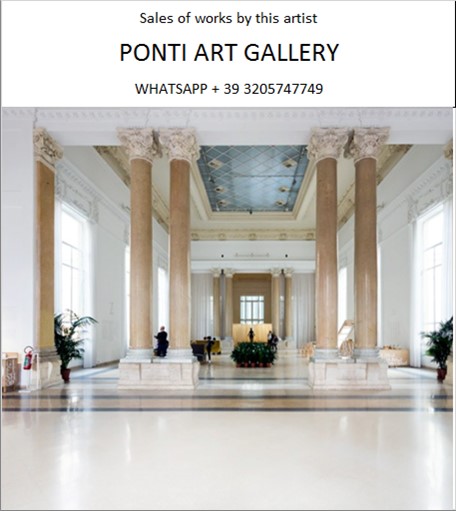Ponti Art Gallery is interested in buying and selling works
of art by this artist.

Virgilio Marchi Biography
Virgilio Marchi was an Italian architect, art director, and painter, whose work and influence were deeply intertwined with the Futurist movement. Born on January 21, 1895, in Livorno, Italy, Marchi's career spanned several decades, during which he made significant contributions to architecture, theatre, and film.
Marchi's early life and education set the stage for his future endeavors. He studied architecture in Siena and Lucca, where he was exposed to the burgeoning artistic and architectural ideas of the time. His education was complemented by his interactions with members of Nuove Tendenze in Milan, a group that was at the forefront of modernist thought in Italy.
In 1920, Marchi wrote his own 'Manifesto of Futurist Architecture,' aligning himself with the values outlined by Antonio Sant’Elia, another prominent figure in the Futurist movement. This manifesto was a declaration of his rejection of the classical past and an embrace of the novelty presented by advancing modes of transport and construction. Marchi's manifesto and his subsequent work reflected a desire to revolutionize architecture and to create spaces that resonated with the dynamism and energy of the modern world.
Marchi's architectural work was characterized by its innovative use of space and materials, as well as its theatricality. In 1921, he was commissioned by Anton Giulio Bragaglia to build the new headquarters of his House of Art with an adjoining theatre in Rome. This project allowed Marchi to experiment with the interplay of vaults, pillars, and arches, creating a space that was reminiscent of the escapes and whims of Futurist architecture. The theatre was a testament to Marchi's ability to blend functionality with avant-garde design, featuring a stage built in opening sections and dressing rooms obtained in ancient tunnels.
Throughout his career, Marchi worked on numerous theatre and film sets, designing more than fifty films. His work in scenography was marked by a distinctive style that brought the bold and visionary concepts of Futurism to the stage and screen. Some of his notable filmography includes "Territorial Militia" (1935), "The Two Sergeants" (1936), "Condottieri" (1937), and "Umberto D." (1952), a film directed by Vittorio De Sica that is often hailed as a masterpiece of Italian neorealism.
Marchi's style evolved over time, reflecting the changing political and economic context of Italy. His later drawings, while still polished and mannered, showed a retreat from the radical ambitions of his earlier work. This shift was evident in his design for the Odeon Cinema (1940), which, when built in 1952, presented a more restrained and compact form compared to the exuberant and sculptural qualities of his early proposals.
Despite the challenges of the post-war era, Marchi continued to emphasize the spatial and expressive qualities of his work. His design for the Odeon Cinema's interior was a celebration of circular and sinuous geometries, articulated by ribbons of light that created a captivating atmosphere for cinema-goers. The cinema hall, originally with 2,500 seats, was a subtly organic trapezoid in plan, balanced by a cantilevered and parabolic gallery floor.
Marchi's contributions to the Futurist movement extended beyond architecture and film. He was also a painter, known for his sketches and drawings that captured the essence of Futurism. His work was featured in various exhibitions and auctions, reflecting the enduring interest in his artistic vision.
Virgilio Marchi passed away on April 30, 1960, in Rome, leaving behind a legacy that continues to be celebrated for its boldness, innovation, and impact on 20th-century art and architecture. His work remains a testament to the power of Futurism and its ability to challenge and inspire new ways of thinking about space, form, and the experience of modernity.
Virgilio Marchi Quotes and
Sales of Works
Ponti Art Gallery selects and deals with paintings by the
artist. Upon request, we provide free estimates and
evaluations, communicate prices, quotations, and current
market values.
If you are interested in BUYING or SELLING works by the
artist, contact us immediately.
If you wish to sell or receive an evaluation of the
works:
Send us a frontal photo of the painting, one of the back,
and one of the signature. Also, indicate the dimensions of
the work. Inform us about the purchase origin of the work
and any kind of available documentation (purchase
receipts, certificates of authenticity, publications). One
of our operators will respond to you on the same day. We
guarantee maximum confidentiality and extreme
professionalism.
If you wish to purchase works by the painter: Contact us
and let us know your request. We will inform you about the
available works. We also offer the possibility to
subscribe to our NEWSLETTER, through which you will be
informed at the beginning of each month about the latest
acquisitions of the art gallery.
You can send us pictures of the work:
